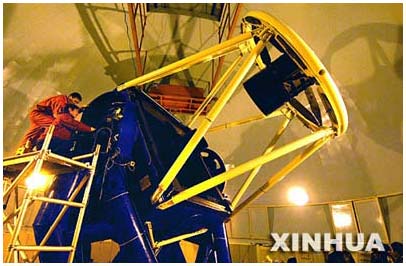East Asia's largest telescope
The optical telescope with a diameter of 2.4 m has been installed successfully at the Lijiang Astronomical Observatory, Yunnan Province, China. This is also one of the largest diameter telescopes in East Asia.
The glass is 8m high, weighs more than 40 tons, the inner diameter is 2.4m, is installed on the roof of the monitoring building with a height of 22.5m. The monitoring station was built on an altitude of 3,250m above the sea, 40km from Le Giang ancient town, this is currently the monitoring station located in the highest position of China.
This telescope is also considered one of the largest diameter glass in East Asia. The feature of glass is rated as reaching the international advanced level.
This glass is manufactured by England, which supports remote control and automatic manipulation. Glass is also fitted with cameras and spectrophotometers in cooperation with Denmark. This glass will be used to study celestial physics and cosmology.
Along with the introduction of the telescope in December, the Le Giang Astronomical Observatory becomes the most important astronomical observation base in South China. Building an astronomical monitoring facility in the South is the aspiration of many generations of Chinese astronomical research.

East Asia's largest telescope in the installation process (Photo: THX)
After years of selective research, scientists decided to place the largest telescope in Lijiang, which is considered to be the most "favorable" location with the appropriate astronomical meteorological conditions such as in beautiful weather, sunny, naked eyes can see the mountains 100km away and up to 260 days / year can be observed at night.
Mr. Ly Diem (Li Yan) - Director of Van Nam Observatory said: After putting into use, every year, the glass can deploy dozens of research and observation of celestial physics topics of national scale. In order to improve the ability of international cooperation in the physical physical measurement.
In the future, Lijiang Observatory will install more telescopes with different diameters.
Tuyet Nhung
- Commencement of the world's largest telescope project in Chile
- The world's largest telescope performs historical mission
- The world's largest telescope
- Close up of the world's largest telescope
- Prepare to install the world's largest telescope
- Kepler's largest telescope in the world has a serious problem
- The world's largest telescope will operate in 2027
- Telescope 'hunt' aliens damaged after the storm
- The world's largest telescope is located in Chile
- China's largest operator, the world's largest telescope
- China builds the world's largest telescope
- NASA completed the telescope looking back past 13 billion years
 Van Allen's belt and evidence that the Apollo 11 mission to the Moon was myth
Van Allen's belt and evidence that the Apollo 11 mission to the Moon was myth The levels of civilization in the universe (Kardashev scale)
The levels of civilization in the universe (Kardashev scale) Today Mars, the sun and the Earth are aligned
Today Mars, the sun and the Earth are aligned The Amazon owner announced a secret plan to build a space base for thousands of people
The Amazon owner announced a secret plan to build a space base for thousands of people